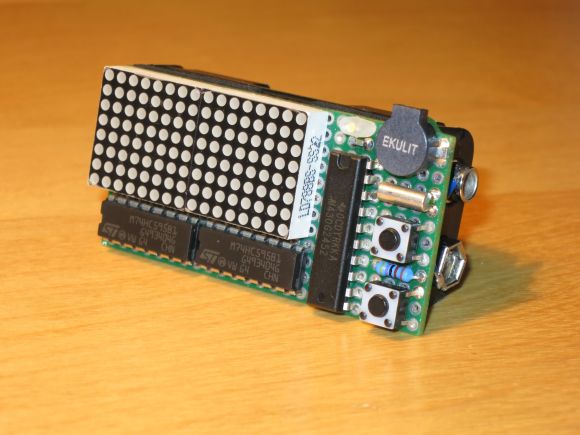
[Markus] turn his breadboard LED matrix tinkering into an alarm clock which wakes him each morning.
Don’t be fooled by how clean his assembly work is. That’s not a fabbed PCB, it’s a hunk of green protoboard which a lot of point-to-point soldering on the back side. It’s driven by the MSP430 G2452 which is oriented vertically in this image. The two horizonal ICs are 595 shift registers which drive the LED modules.
We already mentioned the cleanliness of his assembly, but there’s one other really cool design element. On the back of the unit is what looks like a battery holder for two AA cells. He’s using just one Lithium Iron Phosphate battery (3.2V) which is in the upper of the two cavities. This let him cut the lower part of the holder at an angle to act as a stand for the clock.
Don’t miss the video which walks us through the user interface. It has what you’d expect from an alarm clock. But there is a really bright white LED which mimics a sunrise clock and it does more than just buzz one note when the thing goes off.















Uh-may-zing! I want one so bad!’
Looks really good, I don’t understand the flashing pixels at the bottom though.
A 16th of a minute maybe?
Yes, the left one advances one pixel every four seconds, yielding 15 pixels to represent one full minute. The right one indicates, if an alarm-time is set and armed.
mimics a sunrise clock? well, it flashes like a f****** strobo..
but really, nice work! its so cute!
Nice project and a cool end product.
Love it. But, for me, that flashing LED would be a wasted effort. My bedroom is bathed in sunlight from early early morning during the summer and I sleep right through that hehe.
Just what you need to wake up to… C64 Chip tunes!
Anyone knows if the ASCII Schematic in the post is hand-made or done with a tool? If the latter, what is its name? Thanks!
It’s drawn manually character by character :)
Holy Wow! 8^)
You got my deep respect Markus :)
IMHO better use SCT2024 instead of two 74595.
Very nicely done!
I wonder how long the battery would last?
In standby mode the clock draws about 2.6 uA. Displaying the time consumes about 18 mA (auto power-off after 4 seconds), using it as a flashlight by having the white LED turned on also draws about 18 mA (auto power-off after 1 minute).
The rechargeable LiFePo4 battery I used is rated having 700 mAh @ 3.2 V. Doing the math gives the following theoretical values:
Standby: 30 years
constant on flashlight/displaying time: 43 hours
I guess the real limit is the self discharge of the battery, but LiFePo4 batteries perform quite well in this respect.
So I expect a few years of regular usage before I have to recharge it :)
I love the alarm sound!! Nice work Markus!
nice work bro.could you please attach source code